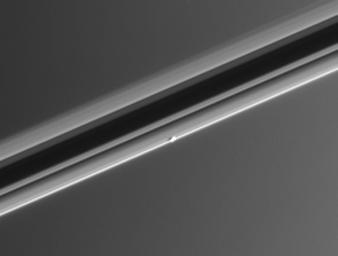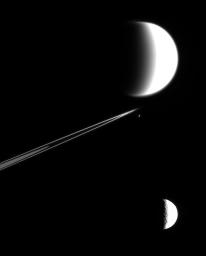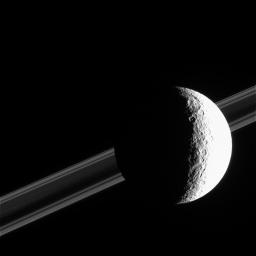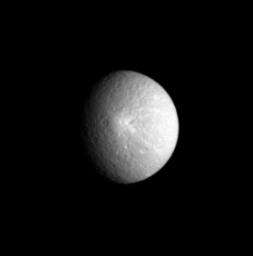The VIMS Nature paper on results from the Ta flyby is now out. They examine a feature they have been calling the snail as well as the surrounding dark terrain, seen in data taken during Ta with resolutions approaching 1.5 km/pixel. Based on spectral and geomorphologic analysis, Sotin and his VIMS collaborators interpret the snail as an ice volcano, within an area of extensional tectonics. The dark region it is in is interpreted as being filled with ridges and valleys, based on photoclinometric analysis of bright and dark banding within the dark terrain.
I'll come right out and say it, I have serious reservations about the interpretations (particularly the photoclinometric analysis) as well as the lack of mention of the other optical instrument that can be used for Titan geology. First, the interpretations: the bright and dark banding in the "snail" image is interpreted by the VIMS team as due to ridges and valleys with a wavelength of 10 km. This goes against what RADAR sees within dark terrain and what ISS sees. RADAR has seen no evidence of ridge and trough terrain on that scale, though they have seen dunes at a much smaller scale. Doesn't mean that such terrain doesn't exist at the snail's location, but it does form reasonable doubt in my mind. Second, ISS sees plenty of albedo variation within the dark terrain that is NOT caused by topography because we can't see it. How would this be any different (photoclinometry uses, as its starting assumption, that there are no albedo variations within the area in question)? I'm not saying that this isn't possible, but I think the VIMS team is reaching.
I do like the idea of the ice volcano. Not saying I completely agree, but it's nice to see they are taking a shot at interpreting what would cause the spiral structure. Louise Prockter's suggestion that it might turn out to be a crater is a valid point to make, but I don't think it fits the observations here (given our observations of other craters).
A few links are in order here. The
paper is by Sotin et al. There is also a
news item by Louise Prockter on this paper and gives a more outside perspective on the results within. A subscription is required to view these papers, but if you shoot me an email and ask very nicely...







